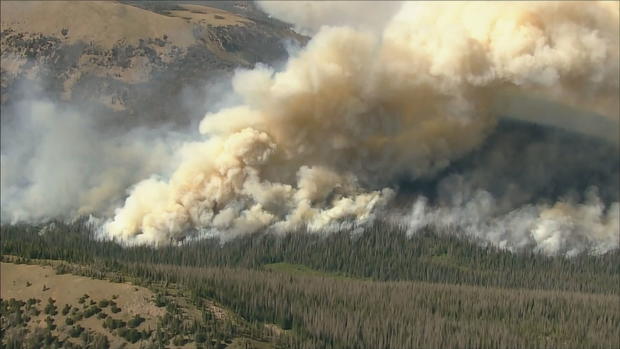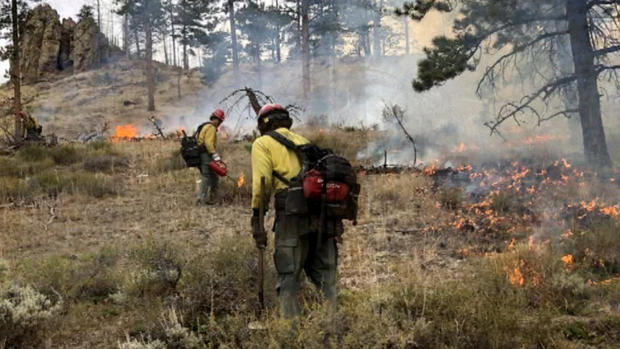Efforts To Contain The Cameron Peak And Future Fires: Forest Managers Explain How Prescribed Burns Help
By L.A. Sklba
FORT COLLINS, Colo. (CBS4) - Forests full of readily available fuel across Colorado create conditions in which wildfires can easily spread. The Forest Service says overstocking is a major concern, and that human activity over the past century, including the suppression of wildfires, has contributed to our forests having an abundance of fuel.
"By putting out all fires small and capturing fire small, it's led to more growth, more overstocking within national forests, or forests as a whole, across the collective Western United States," said Mark Mendonca, with the U.S. Forest Service.
Mendonca is the Deputy Fire Staff Officer of the Arapahoe and Roosevelt National Forests where the historic Cameron Peak Fire burned. He is involved with all fire-related operations in the area.
He told CBS4, suppressing fires to have a minimal footprint means there are more trees, more brush, and more herbaceous components growing. And without adequate thinning or reduction to those areas, overstocking is a likely result.
The U.S. Forest Service has been involved in prescribed burns along the Front Range since the mid-80s and says it is continuing to champion efforts to keep Colorado's forests clean while also keeping residents safe.
"We're utilizing all the tools," Mendonca said.
That includes mechanical treatments and manual treatments like thinning the forests. Then they're following those efforts with prescribed fires, allowing for low intensity burns to move across the forests floor to clean up dead and downed timber, including dead materials from the pine beetle epidemic. This also allows for the forest floor seed bed to open, allowing for new growth such as Aspen tree regeneration.
When asked about the benefit of this work in a practical sense, Mendonca directly pointed to the impact it had on the movement of the Cameron Peak Fire.
"In those areas where we've been able to open up the forest floor and open up the canopy and provide some breaks, it allows for that fire to drop back down to the floor. And the firefighters are able to engage with the direct suppression activities," he explained.
That played a key role in firefighters being able to stop the Cameron Peak Fire from moving into communities, such as the Red Feather Lakes area.
Suppression efforts were also utilized in Rocky Mountain National Park during the 2020 fire season. About 30,000 acres were burned in the park by both the Cameron Peak and East Troublesome fires. That's just under 10% of the park. But it could have been worse.
Rocky Mountain National Park does have a long term fuels treatment plan that they said has been in place for years. The intention of that plan is to have the park prepared at all times for a wildfire. Fire Management Officer for RMNP Mike Lewelling said that in a way, they'd already been fighting the last year's fires 20 years before they even started.
"Our fuels treatments, people before I even got here, recognized the threats to our communities and started a pretty robust fuel reduction program," he said.
He also emphasized that they've become even more intense about how much fuels are being taken out of the park.
"What we're doing isn't changing, because our master fuels plan is hitting the right spots. We've got a long way to go though," he said.
The Forest Service did emphasize that it's not as simple as letting wildfires burn freely to clean out Colorado's forests in order to eventually cut back on the size of wildfires. While there are benefits to wildfires, there are also tradeoffs.
Coloradans know this well, after experiencing smoky skies during last year's fire season.
Mendonca said it's all about using fire in the right place at the right time with the right conditions, and considering who may be impacted.
For example, he said, "Even though we have opportunities on the Arapahoe Roosevelt National Forests where the fire has potential to move around and not necessarily need to be suppressed to the smallest scale, those downstream effects, or down-valley effects, with particulate in the air quality across the Northern Front Range of Colorado is a big deal."
The risks only increase as more Coloradans move into the wildland-urban interface, areas where human development intermingles with undeveloped environments, according to the United States Fire Administration. People are not only more likely to experience the impacts of wildfires, they're also more likely to start them. That includes people who are visiting Colorado's forests to recreate.
"The majority of our wildfires are the result of people in the woods and their actions," Mendonca said.
While the Cameron Peak Fire is thought to be human caused, the exact cause is still under investigation at this time.






